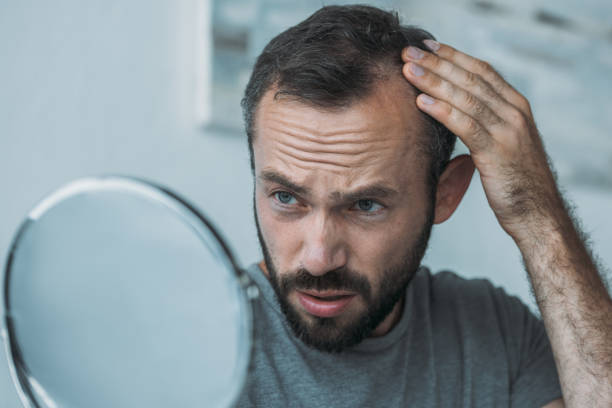Alopecia: An Overview of Causes and Types
Oct 02, 2023
Alopecia, often synonymous with hair loss, affects millions globally, impacting individuals' physical appearance and psychological well-being. Alopecia affects all ages, genders, and races.
Scarring Alopecia
Scarring Alopecia, or cicatricial Alopecia, results in irreversible hair loss. The condition manifests through destroying hair follicles, which are then replaced by scar tissues. Scarring Alopecia can be further classified into several types, including:
- Lichen Planopilaris
- Frontal Fibrosing Alopecia
- Central Centrifugal Cicatricial Alopecia
Each type exhibits unique characteristics, but all share the commonality of causing permanent damage to hair follicles and inhibiting hair regrowth. Scarring Alopecia is often associated with inflammation, itching, and pain, necessitating timely intervention to manage symptoms and halt progression.
Non-Scarring Alopecia
On the other hand, non-scarring Alopecia is characterized by hair loss without permanent damage to the hair follicles. The potential for hair regrowth exists, making early diagnosis and treatment crucial. The subtypes of non-scarring Alopecia include:
- Alopecia Areata: An autoimmune condition where the body attacks its hair follicles, leading to patchy hair loss.
- Traction Alopecia: Resulting from prolonged tension on the hair, commonly due to specific hairstyles or treatments.
- Androgenic Alopecia: This inherited disorder causes hair loss.
Global Prevalence
As per recent statistics, 80 million Americans suffer hereditary hair loss. 6.8 million Americans have a 2.1% lifetime alopecia areata risk. America has 50 million males and 30 million women with traction and androgenic Alopecia.
Age and Gender Variations
No matter gender or age, Alopecia affects everyone. 50% of men lose hair by 50 due to androgenic Alopecia.
- Menopause and other hormonal changes cause hair loss in women.
- Alopecia areata, on the other hand, often starts in childhood, emphasizing the necessity for early awareness and intervention across various age demographics.
Understanding the Causes

Alopecia arises from an array of factors, both genetic and environmental. A deeper insight into these causative elements is essential for healthcare professionals to devise appropriate intervention strategies.
Genetic Factors
Many alopecia cases, especially androgenic ones, are hereditary. A family history of this condition increases risk due to genes that affect hair follicle longevity and density.
Autoimmune Response
The autoimmune nature of Alopecia areata results in the body's immune system mistakenly attacking hair follicles. This erroneous targeting leads to the characteristic patchy hair loss associated with this form of Alopecia, necessitating research into immune modulation as a potential treatment avenue.
Hormonal Changes
Hormones affect hair growth and loss. Alopecia can result from hormonal changes during pregnancy, menopause, or contraceptive pills. Addressing hormonal imbalances is critical to managing hair loss.
Environmental Stressors
Environmental factors that cause hair loss include:
- Physical and emotional stress can cause telogen effluvium or temporary hair loss.
- Poor Nutrition: Iron and protein deficiencies can cause hair loss.
- Medications and Chemicals: Drugs and chemicals can damage hair growth.
Diagnosis and Evaluation
Correctly treating Alopecia requires identifying its forms. A thorough exam and specialized tests are used to diagnose. To guide treatment, determine the type and cause of Alopecia.
Trichogram
A trichogram is a hair pull test that helps assess the proportion of growing hairs to shedding hairs. This test can provide valuable information on the hair growth cycle, revealing whether hair loss is active or stable.
Clinical Examination
A thorough clinical exam is needed to diagnose Alopecia. The doctor will ask about medical history, family hair loss, and recent stress. Alopecia areata causes patchy hair loss, while androgenic Alopecia causes receding hairlines.
Scalp Biopsy
When scarring Alopecia is suspected, a scalp biopsy may be done. A small scalp skin section is removed for microscopic examination. The biopsy can reveal hair follicle damage, inflammation, or scar tissue, improving diagnosis.
Blood Tests
Blood tests are beneficial to rule out other medical conditions that might be causing hair loss. They can evaluate the levels of certain hormones, check for the presence of antibodies typical of alopecia areata, and assess nutritional status. Anomalies in blood test results can indicate the presence of underlying issues contributing to hair loss.
Management and Treatment
Upon establishing a diagnosis, the focus shifts to managing and treating the identified type of Alopecia. Management strategies are tailored to the individual, addressing the physical aspect of hair loss and its psychological impact. Setting realistic goals and exploring choices is crucial.
- Many kinds of Alopecia are treated with medication first. Federally approved minoxidil and finasteride increase hair growth and reduce hair loss for androgenic Alopecia. In alopecia areata, corticosteroids reduce inflammation and encourage hair growth.
- Topical minoxidil helps treat androgenic and areata Alopecia. Directly applied to the scalp, they encourage hair follicles to regrow and prevent hair loss.
- Advanced hair loss, especially from androgenic Alopecia, can be treated with hair transplantation. This surgery moves hair follicles from one place of the body to balding areas to restore a natural hairline.
- Addressing the psychological impact of Alopecia is equally essential. Support groups, counseling, and psychotherapy can help individuals cope with the emotional aspects of hair loss, fostering a positive outlook and enhancing overall well-being.
Prognosis and Future Research

The future for individuals with Alopecia is teeming with potential as ongoing research unveils new treatment options and pathways. Alopecia types vary in prognosis, but early intervention and medical improvements are encouraging.
Research and Development
Alopecia research is rising as experts develop new remedies. Gene therapy, stem cell therapy, and immunological modulation are being studied to treat Alopecia areata and androgenic Alopecia.
Personalized Medicine
The advent of personalized medicine is transforming the treatment landscape for Alopecia. By understanding hair loss's genetic and molecular basis, healthcare providers can tailor treatments to the individual, enhancing efficacy and minimizing adverse effects.
Patient Education and Awareness
Increasing awareness and education about Alopecia are critical. Efforts to educate the public on early signs of hair loss, risk factors for conditions like traction alopecia, and available treatment options can facilitate early intervention and better outcomes.
Lifestyle Modification
Alopecia can be managed by living a healthy lifestyle. Regular exercise, a balanced diet, and stress management may reduce hair loss from numerous causes.





